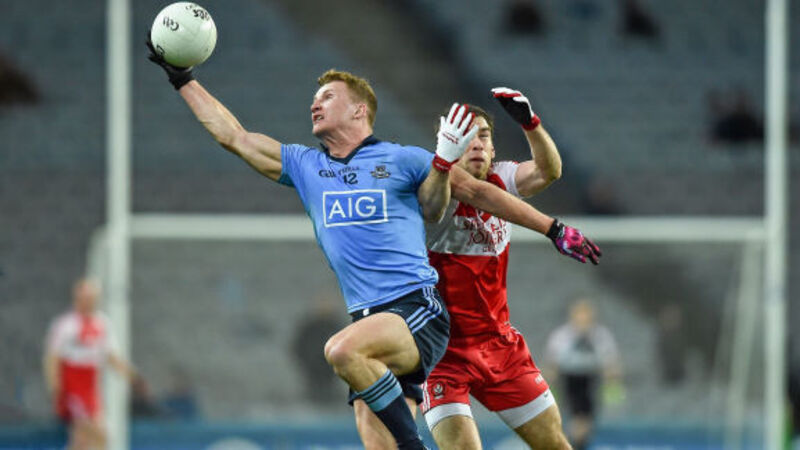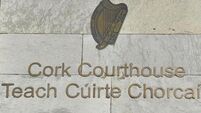Gaelic football isn’t dead but badly needs change of direction

During a discussion about the problems afflicting the game, Mark Sidebottom posed a question to the audience.
“How many of you think inter-county football is entertaining to watch?” asked the BBC commentator.
The response was unanimous. Not a single hand was raised in the air.
Was this another example of groupthink in action, or, was it simply a reflection of grassroots discontent?
It seems that Jarlath Burns, the new chairman of the GAA’s standing committee on playing rules, is in agreement with the citizens of Slaughtneil.
Last week, Burns said he thinks Gaelic football is “unwatchable, at times”.
Thankfully, Burns wants to provide remedies. While he has no fixed ideas about the rules which should be introduced, the former Armagh captain knows how he would like Gaelic football to be played. That’s his starting point.
Speaking to The Irish News last week, Burns pointed to The Seven Habits of Highly Effective People, the international bestseller written by American academic Steven Covey.
“Habit number one is to begin with the end in mind,” said Burns.
It’s probably safe to assume that all lovers of Gaelic football share a similar vision to Jarlath Burns.
In essence, we want to watch a game which showcases the skills which thrill us. We want to see goals, high catches and long-range points.
Beyond the skills, supporters also enjoy the combative aspect of Gaelic football. Once upon a time, it was 14 outfield duels. It was man-against-man and a succession of 50/50 balls. That game is all but extinct.
The zonal defensive system has removed that ebb and flow from the game.
Randomness and unpredictability has been replaced with a safety-first approach. It is just too risky to kick the ball. The modern player prefers a fist pass. During a recent county game, the ball was fist-passed more than 400 times. Statistics like that make me want to cry.
It needs to be stressed that pointing the finger of blame at certain teams will achieve nothing. Appealing to managers to think of the greater good of the game is an even bigger waste of time.
The challenge facing Burns is clear: His committee must create rules which force managers to rethink the theory which underpins negative, cautious, risk-free football.
There is a good reason teams place such an emphasis on defence. It works. It wins games.
Statistics have informed managers that the vast majority of points are scored in close proximity to the ‘D’ on the 20-metre-line.
If a team packs that area of the field with bodies, and doesn’t concede free-kicks, the opposition must shoot from farther out the field. Again, the data is conclusive. The farther away a player shoots, the more likely he is to miss.
That’s why the scoring zone is always clogged with traffic and a huge priority is placed on not conceding goals.
The rationale behind the philosophy makes perfect sense.
Furthermore, managers have also come to realise that possession is king. The team with the ball is in control of the game. In this respect, the Gaelic football of today bears no resemblance to the game that was played by our forebears.
While in defence, sideline balls and free-kicks go sideways or backwards, often to the goalkeeper. Twenty years ago, a pass to the goalkeeper was considered a jailing offence.
Once an attack is stalled by a defensive grid, it is the precursor to a tiresome sequence of fist-passing. It’s all extremely tedious to watch.
More depressingly again, absolutely nothing is going to change unless new rules are introduced.
Yet, with a few simple tweaks, it could be extremely easy to create a very different spectacle.
For example, when teams retreat behind the 45-metre line, they are almost daring the opposition to shoot from that distance. It’s worth the risk. There is an assumption they will miss.
But what if a point scored from the 45-metre line and beyond was worth two points? That creates a whole new dynamic. Will teams pack so many players into the scoring zone if there is a risk of conceding a two-pointer?
Also, will teams insist on holding the ball when there is such a valuable reward for scoring from distance?
A similar argument could be made for raising the value of a goal to four points. To create a game here, the focus shifts to scoring more rather than conceding less, it makes sense to provide a greater reward for scores.
One rule, in particular, could have a massive effect. Short kick-outs need to be banned. During the first half of Sunday’s match in Ballybofey, neither Tyrone nor Donegal contested their quick restarts. Rather than making tackles in a part of the pitch where players can’t score, both teams retreated in their own defences.
Short kick-outs allow the game to develop into a defensive chess match. In last year’s International Rules Test, a new rule was introduced in which all kick-outs had to reach the 45-metre line. Because managers will not be prepared to concede possession at the halfway line, every kick-out will become an aerial contest. This will rekindle the gladiatorial dimension which has been eroded from games. If the mark was brought in, we would finally be promoting and rewarding the high catch.
It is easy to apply the rule to underage grades. Kick-outs can be taken from the 20-metre line.
Another simple rule is worth considering: If all sidelines balls and free-kicks had to be kicked forward when a team is in its own half of the field, it could encourage managers to defend higher up the field.
The idea to limit the number of players in one half of the field needs to be dismissed immediately. Like the sin-bin, it’s unworkable at club level, where there is only one referee, and no neutral linesmen or umpires. It would be an impossible task and we can’t have a two-tiered rule system.
On Saturday night, Dublin beat Derry by 0-8 to 0-4. After 60 minutes of action, the score was 0-4 apiece. One report said the match was ‘turgid’ and ‘mind-numbing’.
On Twitter, Burns declared it was: “The death of football.”
To think that in 2011 the country went berserk when Jim McGuinness brought Donegal into Croke Park and they defended with only a dozen players.
Four years on, and McGuinness now looks like he was positively reckless.
Burns was perhaps guilty of an overstatement. Gaelic football isn’t dead.
However, the game we knew is most certainly dead and it urgently needs to be born again.
Twitter: @HeaneyPaddy












